Exhibit 99.2

| CDB-4124, A NEW ANTIPROGESTIN, IS ACTIVE AGAINST DMBA-INDUCED BREAST CANCER IN RATS. Ronald D. Wiehle†, Konstantin Christov‡ and Rajendra G. Mehta‡, Zonagen, Inc., The Woodlands, TX†, University of Illinois at Chicago, Chicago, IL‡ |
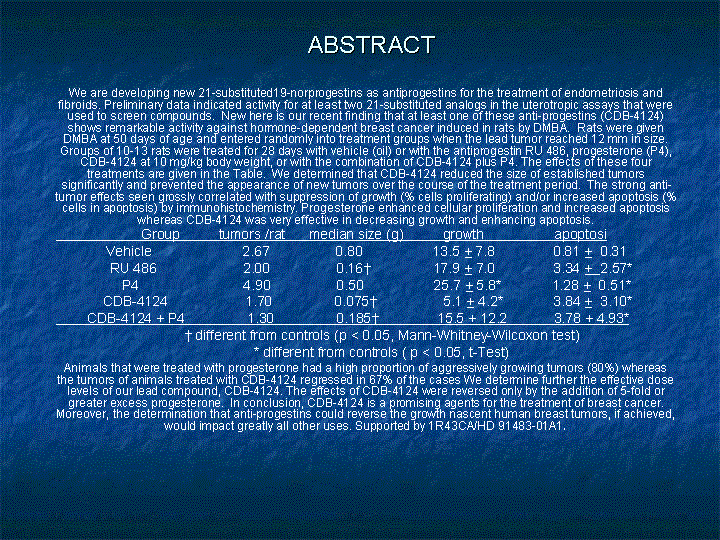
| ABSTRACT We are developing new 21-substituted19-norprogestins as antiprogestins for the treatment of endometriosis and fibroids. Preliminary data indicated activity for at least two 21-substituted analogs in the uterotropic assays that were used to screen compounds. New here is our recent finding that at least one of these anti-progestins (CDB-4124) shows remarkable activity against hormone-dependent breast cancer induced in rats by DMBA. Rats were given DMBA at 50 days of age and entered randomly into treatment groups when the lead tumor reached 12 mm in size. Groups of 10-13 rats were treated for 28 days with vehicle (oil) or with the antiprogestin RU 486, progesterone (P4), CDB-4124 at 10 mg/kg body weight, or with the combination of CDB-4124 plus P4. The effects of these four treatments are given in the Table. We determined that CDB-4124 reduced the size of established tumors significantly and prevented the appearance of new tumors over the course of the treatment period. The strong anti- tumor effects seen grossly correlated with suppression of growth (% cells proliferating) and/or increased apoptosis (% cells in apoptosis) by immunohistochemistry. Progesterone enhanced cellular proliferation and increased apoptosis whereas CDB-4124 was very effective in decreasing growth and enhancing apoptosis. Group tumors /rat median size (g) growth apoptosi Vehicle 2.67 0.80 13.5 + 7.8 0.81 + 0.31 RU 486 2.00 0.16† 17.9 + 7.0 3.34 + 2.57* P4 4.90 0.50 25.7 + 5.8* 1.28 + 0.51* CDB-4124 1.70 0.075† 5.1 + 4.2* 3.84 + 3.10* CDB-4124 + P4 1.30 0.185† 15.5 + 12.2 3.78 + 4.93* † different from controls (p < 0.05, Mann-Whitney-Wilcoxon test) * different from controls ( p < 0.05, t-Test) Animals that were treated with progesterone had a high proportion of aggressively growing tumors (80%) whereas the tumors of animals treated with CDB-4124 regressed in 67% of the cases We determine further the effective dose levels of our lead compound, CDB-4124. The effects of CDB-4124 were reversed only by the addition of 5-fold or greater excess progesterone. In conclusion, CDB-4124 is a promising agents for the treatment of breast cancer. Moreover, the determination that anti-progestins could reverse the growth nascent human breast tumors, if achieved, would impact greatly all other uses. Supported by 1R43CA/HD 91483-01A1. |
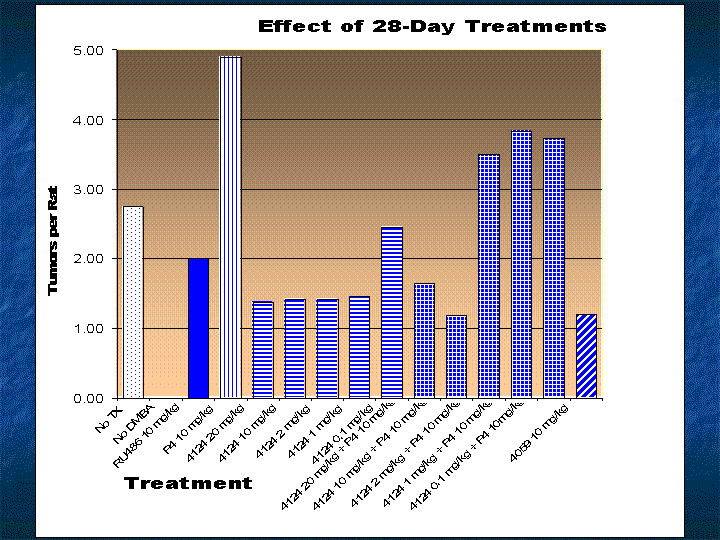
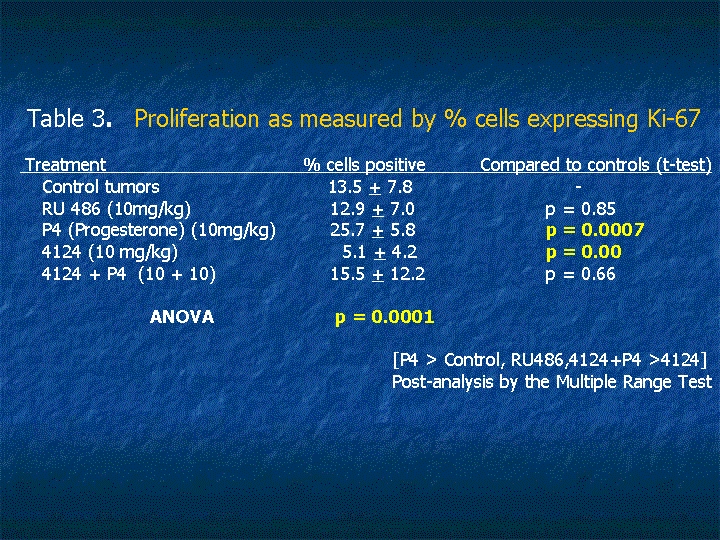
| Table 3. Proliferation as measured by % cells expressing Ki-67 Treatment % cells positive Compared to controls (t-test) Control tumors 13.5 + 7.8 - RU 486 (10mg/kg) 12.9 + 7.0 p = 0.85 P4 (Progesterone) (10mg/kg) 25.7 + 5.8 p = 0.0007 4124 (10 mg/kg) 5.1 + 4.2 p = 0.00 4124 + P4 (10 + 10) 15.5 + 12.2 p = 0.66 ANOVA p = 0.0001 [P4 > Control, RU486,4124+P4 >4124] Post-analysis by the Multiple Range Test |
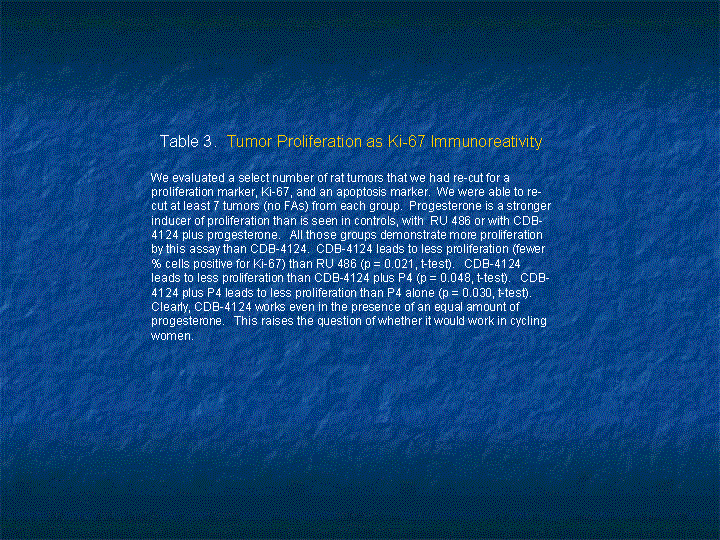
| Table 3. Tumor Proliferation as Ki-67 Immunoreativity We evaluated a select number of rat tumors that we had re-cut for a proliferation marker, Ki-67, and an apoptosis marker. We were able to re- cut at least 7 tumors (no FAs) from each group. Progesterone is a stronger inducer of proliferation than is seen in controls, with RU 486 or with CDB- 4124 plus progesterone. All those groups demonstrate more proliferation by this assay than CDB-4124. CDB-4124 leads to less proliferation (fewer % cells positive for Ki-67) than RU 486 (p = 0.021, t-test). CDB-4124 leads to less proliferation than CDB-4124 plus P4 (p = 0.048, t-test). CDB- 4124 plus P4 leads to less proliferation than P4 alone (p = 0.030, t-test). Clearly, CDB-4124 works even in the presence of an equal amount of progesterone. This raises the question of whether it would work in cycling women. |
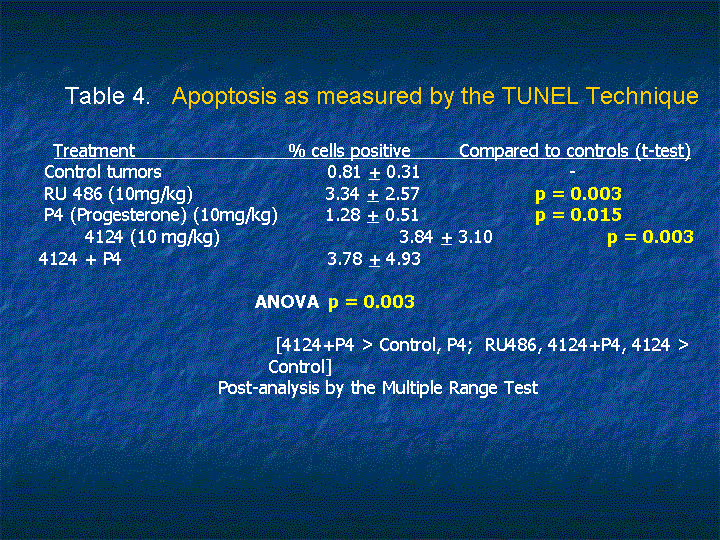
| Table 4. Apoptosis as measured by the TUNEL Technique Treatment % cells positive Compared to controls (t-test) Control tumors 0.81 + 0.31 - RU 486 (10mg/kg) 3.34 + 2.57 p = 0.003 P4 (Progesterone) (10mg/kg) 1.28 + 0.51 p = 0.015 4124 (10 mg/kg) 3.84 + 3.10 p = 0.003 4124 + P4 3.78 + 4.93 ANOVA p = 0.003 [4124+P4 > Control, P4; RU486, 4124+P4, 4124 > Control] Post-analysis by the Multiple Range Test |

| Table 4. Tumor Apoptosis along with Proliferation. We evaluated the same tumors as in Table 3 for apoptosis by the TUNEL technique. CDB-4124+P4 demonstrates more apoptosis than the controls or progesterone alone. RU 486, CDB-4124 plus progesterone and CDB-4124 lead to more apoptosis than controls. CDB-4124 leads to no difference in apoptosis compared to RU 486 (p = 0.73, t-test). CDB-4124 leads to the same level of apoptosis in the presence or absence of an equal amount to added progesterone (p = 0.98, t-test). CDB- 4124 + P4 leads to no difference in apoptosis compared to P4 (p = 0.13, t-test). CDB-4124 + P4 leads to no further increase in apoptosis compared to P4 alone (p = 0.065, one-tailed t-test). CDB-4124 leads to increased apoptosis compared to P4 (p = 0.020, t-test). There is no apparent synergism between CDB-4124 and progesterone. In general, actions of CDB-4124 on decreasing proliferation appear to the key. Both RU 486 and CDB-4124 were effective in this model with CDB- 4124 being more effective. The major difference between them is that CDB- 4124 was better able to reduce proliferation. Thus, we infer an interruption or suppression of a strong proliferative effect of progesterone. |
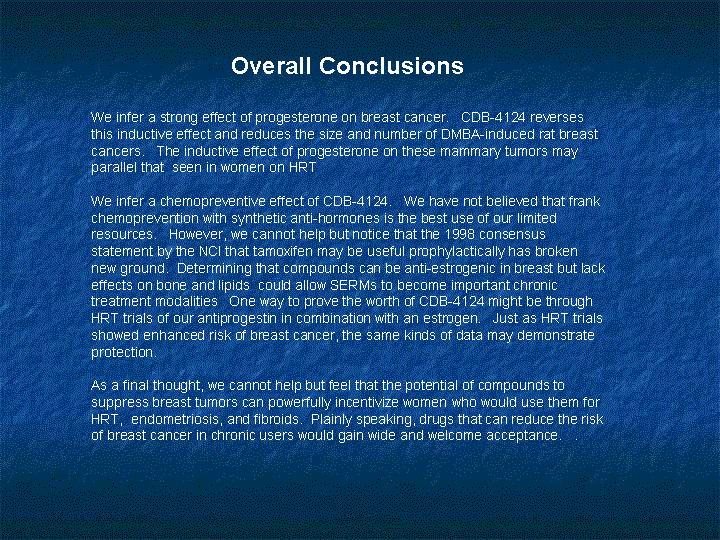
| Overall Conclusions We infer a strong effect of progesterone on breast cancer. CDB-4124 reverses this inductive effect and reduces the size and number of DMBA-induced rat breast cancers. The inductive effect of progesterone on these mammary tumors may parallel that seen in women on HRT We infer a chemopreventive effect of CDB-4124. We have not believed that frank chemoprevention with synthetic anti-hormones is the best use of our limited resources. However, we cannot help but notice that the 1998 consensus statement by the NCI that tamoxifen may be useful prophylactically has broken new ground. Determining that compounds can be anti-estrogenic in breast but lack effects on bone and lipids could allow SERMs to become important chronic treatment modalities One way to prove the worth of CDB-4124 might be through HRT trials of our antiprogestin in combination with an estrogen. Just as HRT trials showed enhanced risk of breast cancer, the same kinds of data may demonstrate protection. As a final thought, we cannot help but feel that the potential of compounds to suppress breast tumors can powerfully incentivize women who would use them for HRT, endometriosis, and fibroids. Plainly speaking, drugs that can reduce the risk of breast cancer in chronic users would gain wide and welcome acceptance. . |
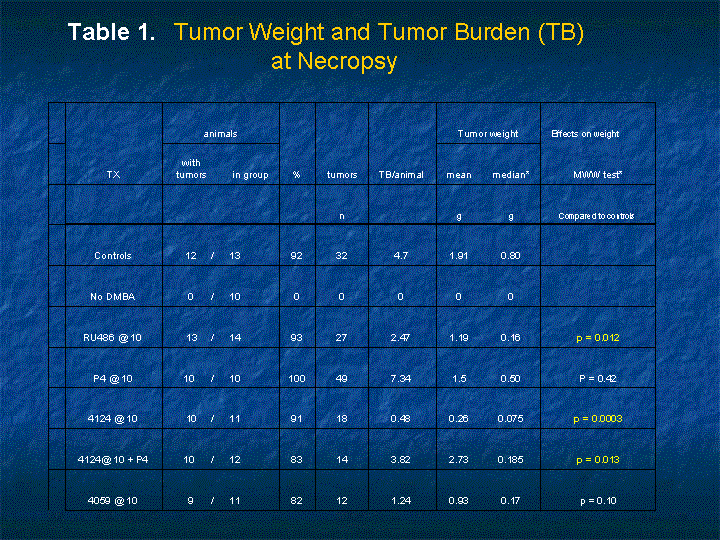
| Table 1. Tumor Weight and Tumor Burden (TB) at Necropsy animals animals Tumor weight Tumor weight Effects on weight TX with tumors in group % tumors TB/animal mean median* MWW test* n g g Compared to controls Controls 12 / 13 92 32 4.7 1.91 0.80 No DMBA 0 / 10 0 0 0 0 0 RU486 @ 10 13 / 14 93 27 2.47 1.19 0.16 p = 0.012 P4 @ 10 10 / 10 100 49 7.34 1.5 0.50 P = 0.42 4124 @ 10 10 / 11 91 18 0.48 0.26 0.075 p = 0.0003 4124@ 10 + P4 10 / 12 83 14 3.82 2.73 0.185 p = 0.013 4059 @ 10 9 / 11 82 12 1.24 0.93 0.17 p = 0.10 |
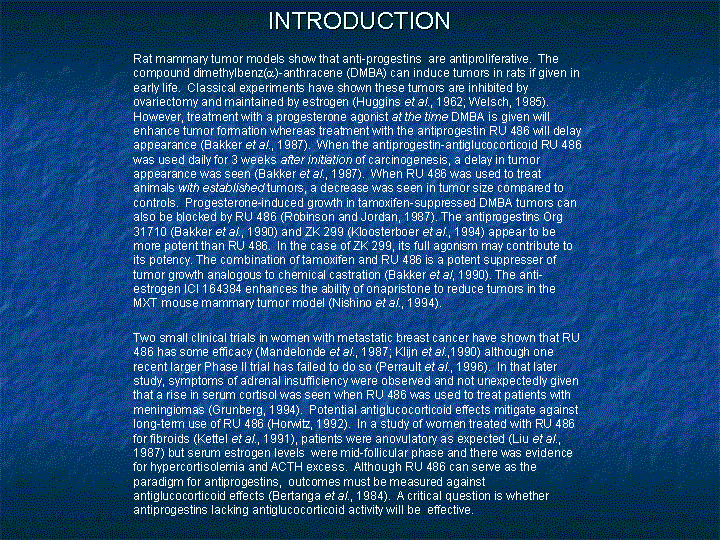
| INTRODUCTION Rat mammary tumor models show that anti-progestins are antiproliferative. The compound dimethylbenz(?)-anthracene (DMBA) can induce tumors in rats if given in early life. Classical experiments have shown these tumors are inhibited by ovariectomy and maintained by estrogen (Huggins et al., 1962; Welsch, 1985). However, treatment with a progesterone agonist at the time DMBA is given will enhance tumor formation whereas treatment with the antiprogestin RU 486 will delay appearance (Bakker et al., 1987). When the antiprogestin-antiglucocorticoid RU 486 was used daily for 3 weeks after initiation of carcinogenesis, a delay in tumor appearance was seen (Bakker et al., 1987). When RU 486 was used to treat animals with established tumors, a decrease was seen in tumor size compared to controls. Progesterone-induced growth in tamoxifen-suppressed DMBA tumors can also be blocked by RU 486 (Robinson and Jordan, 1987). The antiprogestins Org 31710 (Bakker et al., 1990) and ZK 299 (Kloosterboer et al., 1994) appear to be more potent than RU 486. In the case of ZK 299, its full agonism may contribute to its potency. The combination of tamoxifen and RU 486 is a potent suppresser of tumor growth analogous to chemical castration (Bakker et al, 1990). The anti- estrogen ICI 164384 enhances the ability of onapristone to reduce tumors in the MXT mouse mammary tumor model (Nishino et al., 1994). Two small clinical trials in women with metastatic breast cancer have shown that RU 486 has some efficacy (Mandelonde et al., 1987; Klijn et al.,1990) although one recent larger Phase II trial has failed to do so (Perrault et al., 1996). In that later study, symptoms of adrenal insufficiency were observed and not unexpectedly given that a rise in serum cortisol was seen when RU 486 was used to treat patients with meningiomas (Grunberg, 1994). Potential antiglucocorticoid effects mitigate against long-term use of RU 486 (Horwitz, 1992). In a study of women treated with RU 486 for fibroids (Kettel et al., 1991), patients were anovulatory as expected (Liu et al., 1987) but serum estrogen levels were mid-follicular phase and there was evidence for hypercortisolemia and ACTH excess. Although RU 486 can serve as the paradigm for antiprogestins, outcomes must be measured against antiglucocorticoid effects (Bertanga et al., 1984). A critical question is whether antiprogestins lacking antiglucocorticoid activity will be effective. |
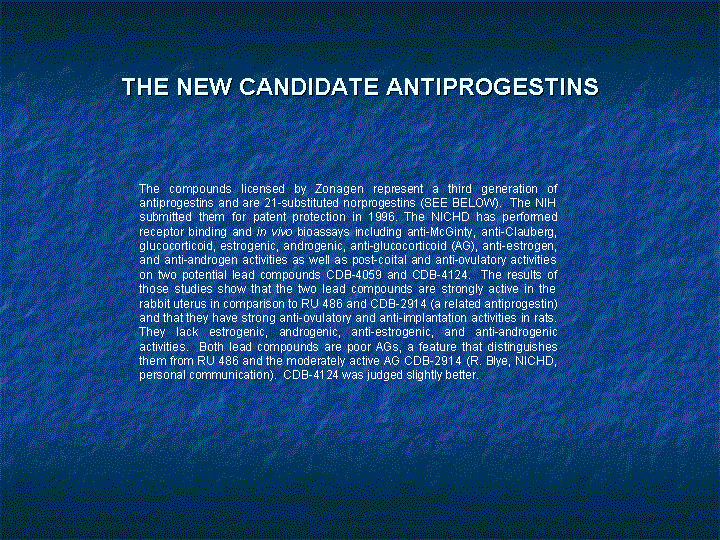
| THE NEW CANDIDATE ANTIPROGESTINS The compounds licensed by Zonagen represent a third generation of antiprogestins and are 21-substituted norprogestins (SEE BELOW). The NIH submitted them for patent protection in 1996. The NICHD has performed receptor binding and in vivo bioassays including anti-McGinty, anti-Clauberg, glucocorticoid, estrogenic, androgenic, anti-glucocorticoid (AG), anti-estrogen, and anti-androgen activities as well as post-coital and anti-ovulatory activities on two potential lead compounds CDB-4059 and CDB-4124. The results of those studies show that the two lead compounds are strongly active in the rabbit uterus in comparison to RU 486 and CDB-2914 (a related antiprogestin) and that they have strong anti-ovulatory and anti-implantation activities in rats. They lack estrogenic, androgenic, anti-estrogenic, and anti-androgenic activities. Both lead compounds are poor AGs, a feature that distinguishes them from RU 486 and the moderately active AG CDB-2914 (R. Blye, NICHD, personal communication). CDB-4124 was judged slightly better. |

| SPECIFIC AIMS The antiprogestin, RU 486, is now approved for use in the U.S. Its effectiveness as an abortifacient is proven but its potential for adjuvant therapy of breast cancer, although suggestive, is complicated by antiglucocorticoid effects. New antiprogestins could be better drugs if their activity can be demonstrated. Therefore, the specific aims l were: 1. The ability of a candidate antiprogestins (CDB- 4124) to alter the growth of established DMBA- induced tumors in rats. 2. The efficacy of CDB-4124 compared to RU 486 in the same system 3. The effects of CDB-4124 on the hormonal profile of treated animals Results from this study would allow Zonagen to determine whether our lead compound, CDB-4124, is active as a therapeutic agent and the dose-response. The results will hasten rational development of safe antiprogestins for women with breast cancer. |
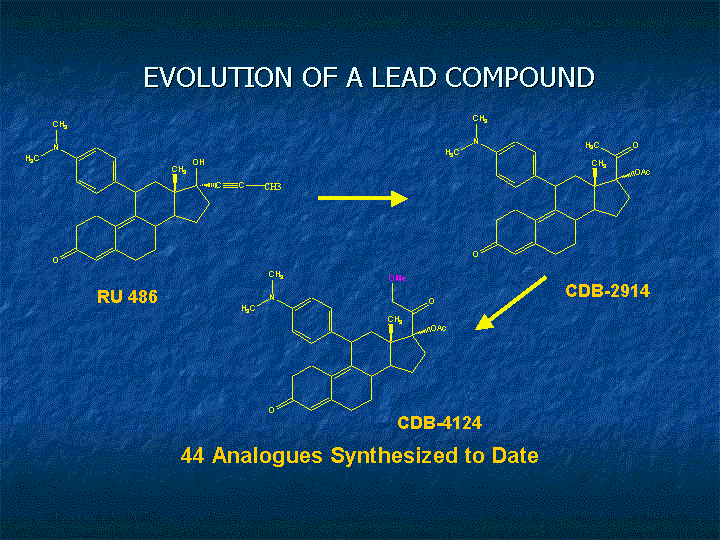
| EVOLUTION OF A LEAD COMPOUND 44 Analogues Synthesized to Date RU 486 CDB-2914 CDB-4124 |
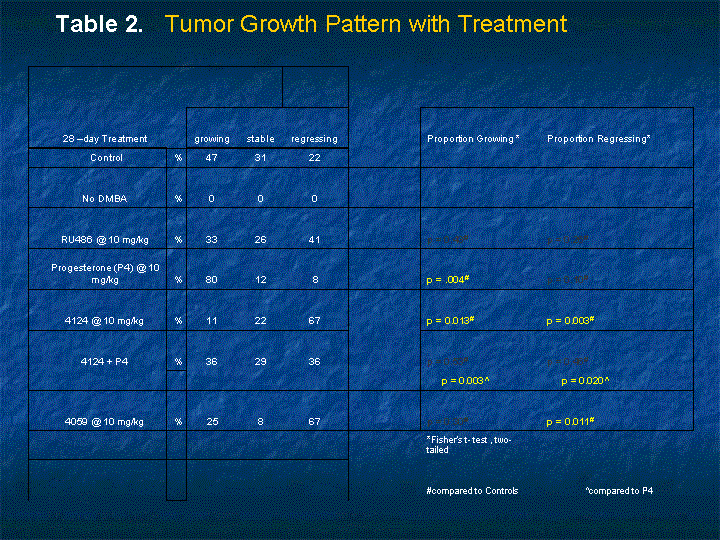
| Table 2. Tumor Growth Pattern with Treatment 28 -day Treatment growing stable regressing Proportion Growing * Proportion Regressing* Control % 47 31 22 No DMBA % 0 0 0 RU486 @ 10 mg/kg % 33 26 41 p = 0.43# p = 0.26# Progesterone (P4) @ 10 mg/kg % 80 12 8 p = .004# p = 0.10# 4124 @ 10 mg/kg % 11 22 67 p = 0.013# p = 0.003# 4124 + P4 % 36 29 36 p = 0.53# p = 0.46# p = 0.003^ p = 0.020^ 4059 @ 10 mg/kg % 25 8 67 p = 0.30# p = 0.011# *Fisher's t- test , two-tailed #compared to Controls ^compared to P4 |
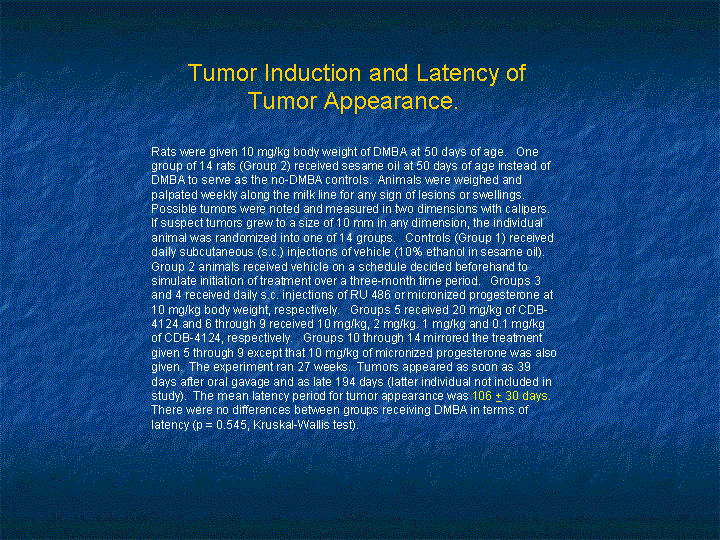
| Tumor Induction and Latency of Tumor Appearance. Rats were given 10 mg/kg body weight of DMBA at 50 days of age. One group of 14 rats (Group 2) received sesame oil at 50 days of age instead of DMBA to serve as the no-DMBA controls. Animals were weighed and palpated weekly along the milk line for any sign of lesions or swellings. Possible tumors were noted and measured in two dimensions with calipers. If suspect tumors grew to a size of 10 mm in any dimension, the individual animal was randomized into one of 14 groups. Controls (Group 1) received daily subcutaneous (s.c.) injections of vehicle (10% ethanol in sesame oil). Group 2 animals received vehicle on a schedule decided beforehand to simulate initiation of treatment over a three-month time period. Groups 3 and 4 received daily s.c. injections of RU 486 or micronized progesterone at 10 mg/kg body weight, respectively. Groups 5 received 20 mg/kg of CDB- 4124 and 6 through 9 received 10 mg/kg, 2 mg/kg. 1 mg/kg and 0.1 mg/kg of CDB-4124, respectively. Groups 10 through 14 mirrored the treatment given 5 through 9 except that 10 mg/kg of micronized progesterone was also given. The experiment ran 27 weeks. Tumors appeared as soon as 39 days after oral gavage and as late 194 days (latter individual not included in study). The mean latency period for tumor appearance was 106 + 30 days. There were no differences between groups receiving DMBA in terms of latency (p = 0.545, Kruskal-Wallis test). |

| STUDY SUMMARY ^ Tumors were smaller when treated with RU 486, CDB-4124 and CDB-4059. We determined the latency period and the dose/duration of CDB-4124 that were near-maximally effective. We had employed RU 486 as the gold standard. We now believe CDB-4124 is the more effective agent for and CDB-4059 may be its equal or better ^ The effects of CDB-4124 were suppressible by overwhelming the antiprogestin with exogenous progesterone. ^ Within the 28-day window of treatment, RU 486, CDB-4124 and CDB-4059 were able to reduce the number of new tumors. ^ RU 486 and CDB-4124 affect both proliferation and apoptosis with CDB-4124 being the most active anti-growth agent. Interestingly, CDB-4124 and progesterone both increase the number of cells in apoptosis. ^ We see increases in serum progesterone with high doses of CDB-4124 and, in fact, the effects on tumors take place in a progesterone-rich milieu. We see no effects on the glucocorticoid of rats, corticosterone. |
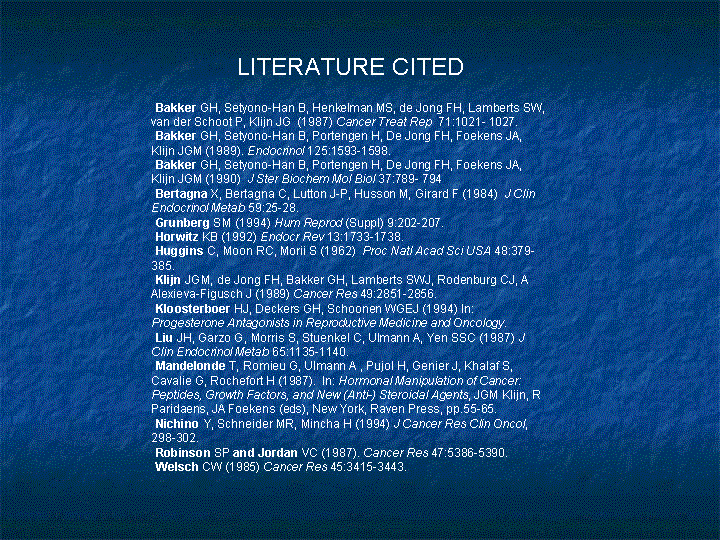
| LITERATURE CITED Bakker GH, Setyono-Han B, Henkelman MS, de Jong FH, Lamberts SW, van der Schoot P, Klijn JG (1987) Cancer Treat Rep 71:1021- 1027. Bakker GH, Setyono-Han B, Portengen H, De Jong FH, Foekens JA, Klijn JGM (1989). Endocrinol 125:1593-1598. Bakker GH, Setyono-Han B, Portengen H, De Jong FH, Foekens JA, Klijn JGM (1990) J Ster Biochem Mol Biol 37:789- 794 Bertagna X, Bertagna C, Lutton J-P, Husson M, Girard F (1984) J Clin Endocrinol Metab 59:25-28. Grunberg SM (1994) Hum Reprod (Suppl) 9:202-207. Horwitz KB (1992) Endocr Rev 13:1733-1738. Huggins C, Moon RC, Morii S (1962) Proc Natl Acad Sci USA 48:379- 385. Klijn JGM, de Jong FH, Bakker GH, Lamberts SWJ, Rodenburg CJ, A Alexieva-Figusch J (1989) Cancer Res 49:2851-2856. Kloosterboer HJ, Deckers GH, Schoonen WGEJ (1994) In: Progesterone Antagonists in Reproductive Medicine and Oncology. Liu JH, Garzo G, Morris S, Stuenkel C, Ulmann A, Yen SSC (1987) J Clin Endocrinol Metab 65:1135-1140. Mandelonde T, Romieu G, Ulmann A , Pujol H, Genier J, Khalaf S, Cavalie G, Rochefort H (1987). In: Hormonal Manipulation of Cancer: Peptides, Growth Factors, and New (Anti-) Steroidal Agents, JGM Klijn, R Paridaens, JA Foekens (eds), New York, Raven Press, pp.55-65. Nichino Y, Schneider MR, Mincha H (1994) J Cancer Res Clin Oncol, 298-302. Robinson SP and Jordan VC (1987). Cancer Res 47:5386-5390. Welsch CW (1985) Cancer Res 45:3415-3443. |
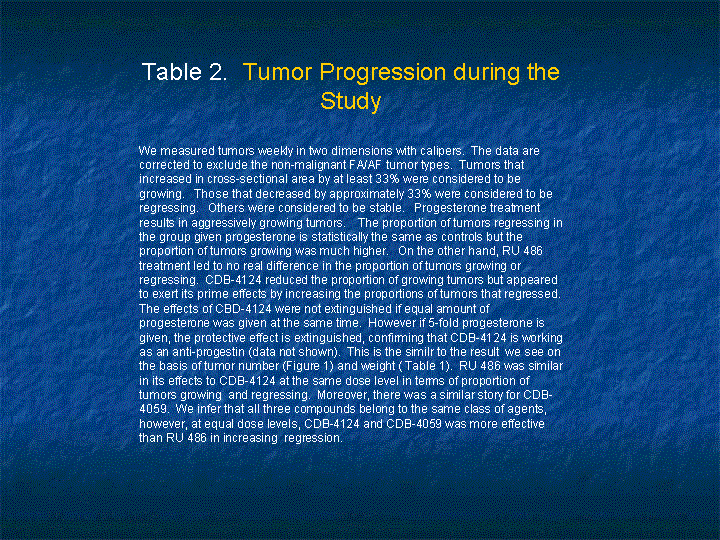
| Table 2. Tumor Progression during the Study We measured tumors weekly in two dimensions with calipers. The data are corrected to exclude the non-malignant FA/AF tumor types. Tumors that increased in cross-sectional area by at least 33% were considered to be growing. Those that decreased by approximately 33% were considered to be regressing. Others were considered to be stable. Progesterone treatment results in aggressively growing tumors. The proportion of tumors regressing in the group given progesterone is statistically the same as controls but the proportion of tumors growing was much higher. On the other hand, RU 486 treatment led to no real difference in the proportion of tumors growing or regressing. CDB-4124 reduced the proportion of growing tumors but appeared to exert its prime effects by increasing the proportions of tumors that regressed. The effects of CBD-4124 were not extinguished if equal amount of progesterone was given at the same time. However if 5-fold progesterone is given, the protective effect is extinguished, confirming that CDB-4124 is working as an anti-progestin (data not shown). This is the similr to the result we see on the basis of tumor number (Figure 1) and weight ( Table 1). RU 486 was similar in its effects to CDB-4124 at the same dose level in terms of proportion of tumors growing and regressing. Moreover, there was a similar story for CDB- 4059. We infer that all three compounds belong to the same class of agents, however, at equal dose levels, CDB-4124 and CDB-4059 was more effective than RU 486 in increasing regression. |
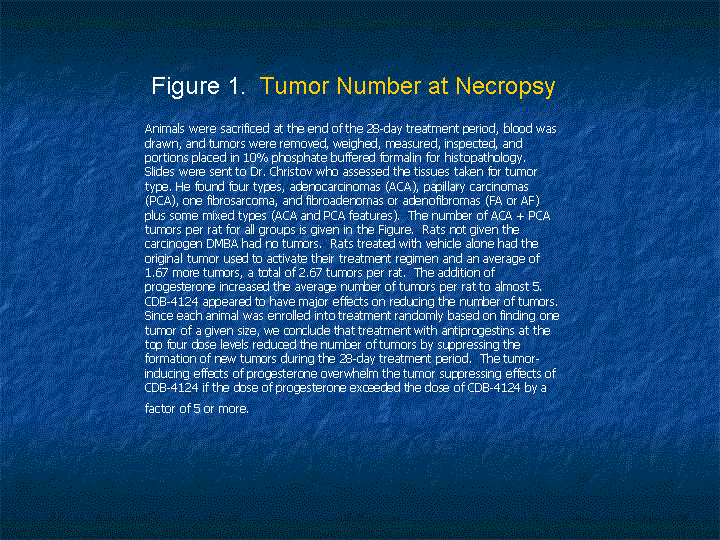
| Figure 1. Tumor Number at Necropsy Animals were sacrificed at the end of the 28-day treatment period, blood was drawn, and tumors were removed, weighed, measured, inspected, and portions placed in 10% phosphate buffered formalin for histopathology. Slides were sent to Dr. Christov who assessed the tissues taken for tumor type. He found four types, adenocarcinomas (ACA), papillary carcinomas (PCA), one fibrosarcoma, and fibroadenomas or adenofibromas (FA or AF) plus some mixed types (ACA and PCA features). The number of ACA + PCA tumors per rat for all groups is given in the Figure. Rats not given the carcinogen DMBA had no tumors. Rats treated with vehicle alone had the original tumor used to activate their treatment regimen and an average of 1.67 more tumors, a total of 2.67 tumors per rat. The addition of progesterone increased the average number of tumors per rat to almost 5. CDB-4124 appeared to have major effects on reducing the number of tumors. Since each animal was enrolled into treatment randomly based on finding one tumor of a given size, we conclude that treatment with antiprogestins at the top four dose levels reduced the number of tumors by suppressing the formation of new tumors during the 28-day treatment period. The tumor- inducing effects of progesterone overwhelm the tumor suppressing effects of CDB-4124 if the dose of progesterone exceeded the dose of CDB-4124 by a factor of 5 or more. |
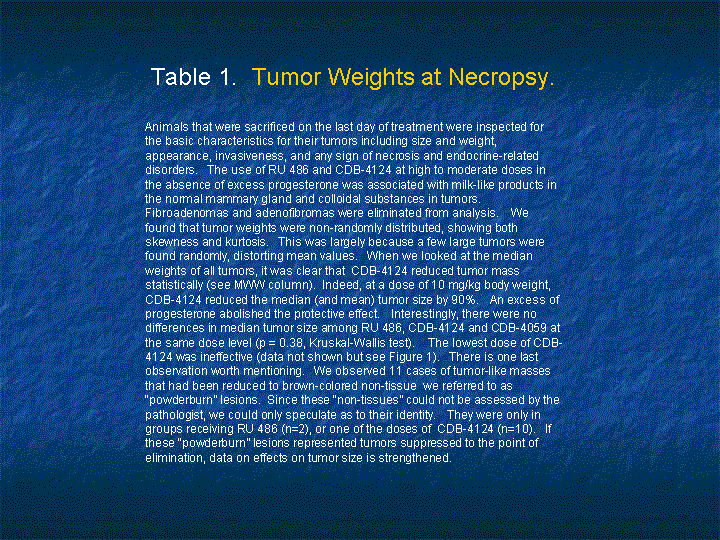
| Table 1. Tumor Weights at Necropsy. Animals that were sacrificed on the last day of treatment were inspected for the basic characteristics for their tumors including size and weight, appearance, invasiveness, and any sign of necrosis and endocrine-related disorders. The use of RU 486 and CDB-4124 at high to moderate doses in the absence of excess progesterone was associated with milk-like products in the normal mammary gland and colloidal substances in tumors. Fibroadenomas and adenofibromas were eliminated from analysis. We found that tumor weights were non-randomly distributed, showing both skewness and kurtosis. This was largely because a few large tumors were found randomly, distorting mean values. When we looked at the median weights of all tumors, it was clear that CDB-4124 reduced tumor mass statistically (see MWW column). Indeed, at a dose of 10 mg/kg body weight, CDB-4124 reduced the median (and mean) tumor size by 90%. An excess of progesterone abolished the protective effect. Interestingly, there were no differences in median tumor size among RU 486, CDB-4124 and CDB-4059 at the same dose level (p = 0.38, Kruskal-Wallis test). The lowest dose of CDB- 4124 was ineffective (data not shown but see Figure 1). There is one last observation worth mentioning. We observed 11 cases of tumor-like masses that had been reduced to brown-colored non-tissue we referred to as "powderburn" lesions. Since these "non-tissues" could not be assessed by the pathologist, we could only speculate as to their identity. They were only in groups receiving RU 486 (n=2), or one of the doses of CDB-4124 (n=10). If these "powderburn" lesions represented tumors suppressed to the point of elimination, data on effects on tumor size is strengthened. |
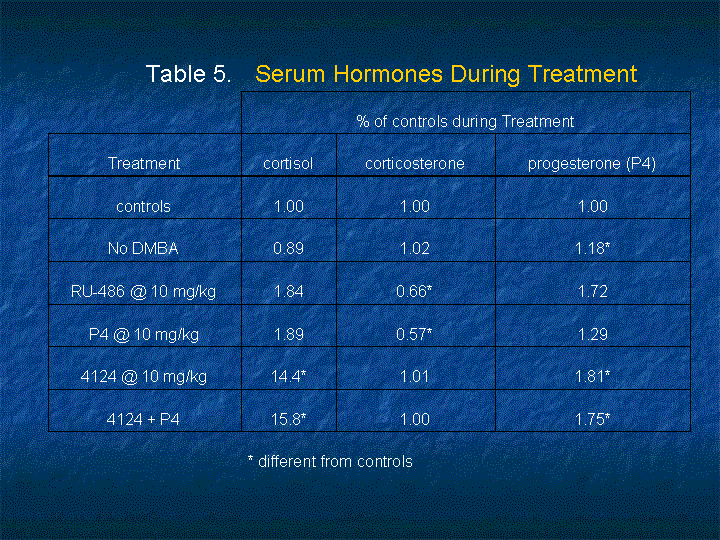
| Table 5. Serum Hormones During Treatment Serum Hormones During Treatment Serum Hormones During Treatment % of controls during Treatment % of controls during Treatment % of controls during Treatment Treatment cortisol corticosterone progesterone (P4) controls 1.00 1.00 1.00 No DMBA 0.89 1.02 1.18* RU-486 @ 10 mg/kg 1.84 0.66* 1.72 P4 @ 10 mg/kg 1.89 0.57* 1.29 4124 @ 10 mg/kg 14.4* 1.01 1.81* 4124 + P4 15.8* 1.00 1.75* * different from controls * different from controls |

| ABSTRACT Background: Clomid is a mixture of two stereoisomers: Enclomiphene, an estrogen antagonist and Zuclomiphene, a mixed agonist. Objectives: We reasoned that the isomer composition and differences in half-life could contribute to its affects. We tested pure isomers against the mixture in males. Methods and Results: When we gave Clomid, Enclomiphene or Zuclomiphene to rats, Zuclomiphene reduced serum testosterone dramatically. However, in a study in baboons where preparations were given at 1.5 mg/kg body weight for 12 days, Zuclomiphene led to lower levels of serum testosterone (178 ng/dL) by day 6 but not the near-castration levels anticipated. Enclomiphene increased total serum testosterone to 1144 ng/dL, significantly higher than the Clomid group (559 ng/dL). We followed up the latter results with a randomized, double-blind, placebo-and active-controlled study in hypogonadal men evaluating oral enclomiphene between 12.5 and 50 mg. Subjects at screening were low-to-borderline (99 to 334 ng/dL) in total testosterone with normal LH and FSH. nine to eleven men completed each arm of the study. After 15 days, the placebo group showed no increase in total testosterone over day 1. There was an apparent dose-dependent rise with enclomiphene: 12.5 mg/day was associated with an increase of 207ng/dL, 25 mg/day with 250 ng/dL, and 50 mg/day with 301 mg/dL. The active-control agent, AndroGel(r) 1% increase testosterone by 256 ng/dL. Treatment with 50 mg/day of enclomiphene led to a mean total serum testosterone within the normal range. Conclusions: Enclomiphene is able to raise testosterone and may represent a new modality for men with secondary hypogonadism. |
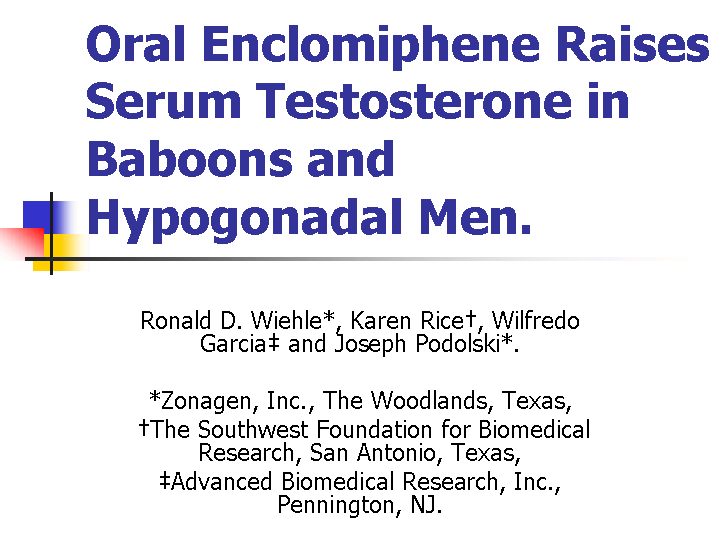
| Oral Enclomiphene Raises Serum Testosterone in Baboons and Hypogonadal Men. Ronald D. Wiehle*, Karen Rice†, Wilfredo Garcia‡ and Joseph Podolski*. *Zonagen, Inc., The Woodlands, Texas, †The Southwest Foundation for Biomedical Research, San Antonio, Texas, ‡Advanced Biomedical Research, Inc., Pennington, NJ. |
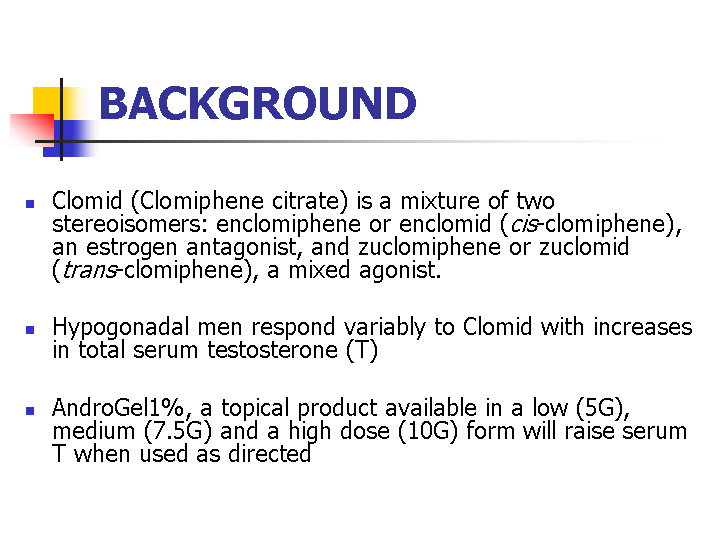
| BACKGROUND Clomid (Clomiphene citrate) is a mixture of two stereoisomers: enclomiphene or enclomid (cis-clomiphene), an estrogen antagonist, and zuclomiphene or zuclomid (trans-clomiphene), a mixed agonist. Hypogonadal men respond variably to Clomid with increases in total serum testosterone (T) AndroGel1%, a topical product available in a low (5G), medium (7.5G) and a high dose (10G) form will raise serum T when used as directed |
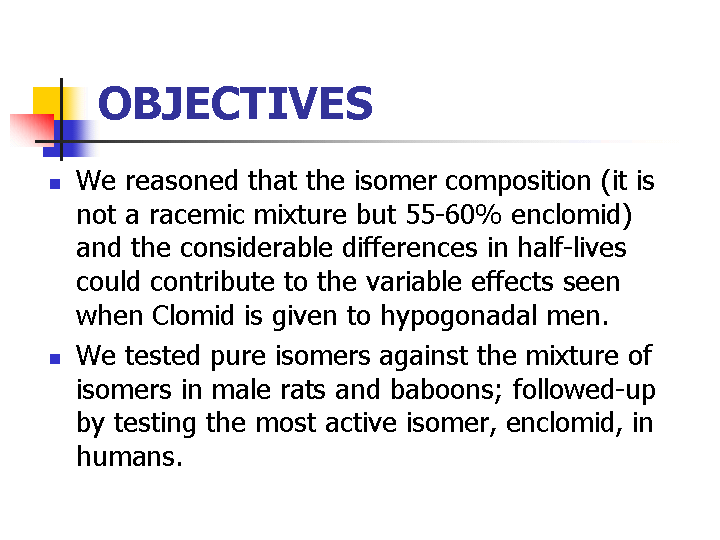
| OBJECTIVES We reasoned that the isomer composition (it is not a racemic mixture but 55-60% enclomid) and the considerable differences in half-lives could contribute to the variable effects seen when Clomid is given to hypogonadal men. We tested pure isomers against the mixture of isomers in male rats and baboons; followed-up by testing the most active isomer, enclomid, in humans. |
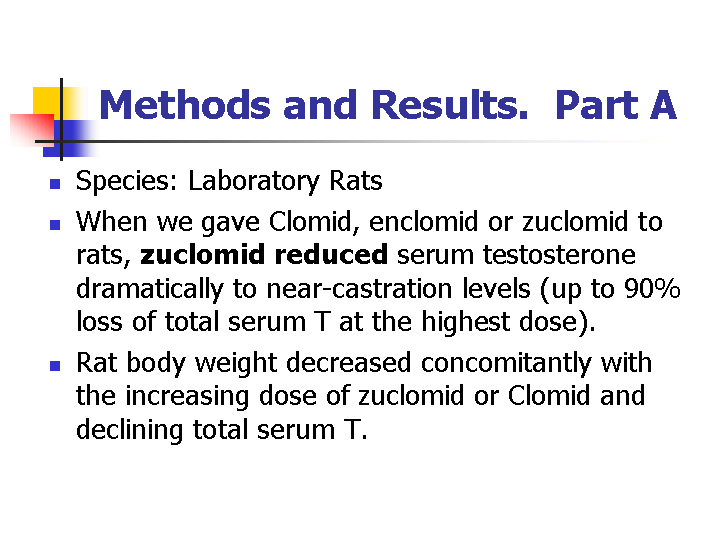
| Methods and Results. Part A Species: Laboratory Rats When we gave Clomid, enclomid or zuclomid to rats, zuclomid reduced serum testosterone dramatically to near-castration levels (up to 90% loss of total serum T at the highest dose). Rat body weight decreased concomitantly with the increasing dose of zuclomid or Clomid and declining total serum T. |
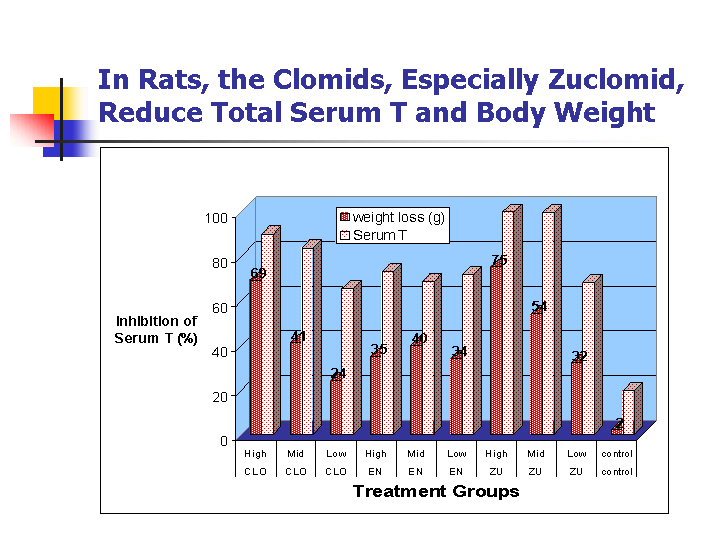
| In Rats, the Clomids, Especially Zuclomid, Reduce Total Serum T and Body Weight |
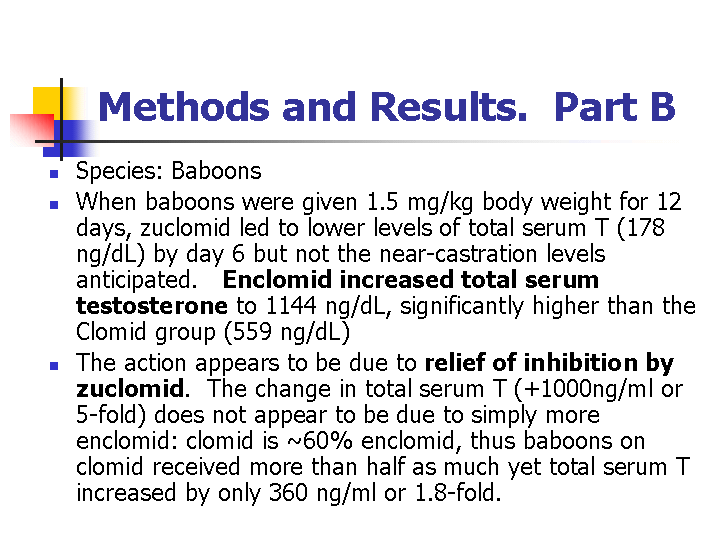
| Methods and Results. Part B Species: Baboons When baboons were given 1.5 mg/kg body weight for 12 days, zuclomid led to lower levels of total serum T (178 ng/dL) by day 6 but not the near-castration levels anticipated. Enclomid increased total serum testosterone to 1144 ng/dL, significantly higher than the Clomid group (559 ng/dL) The action appears to be due to relief of inhibition by zuclomid. The change in total serum T (+1000ng/ml or 5-fold) does not appear to be due to simply more enclomid: clomid is ~60% enclomid, thus baboons on clomid received more than half as much yet total serum T increased by only 360 ng/ml or 1.8-fold. |
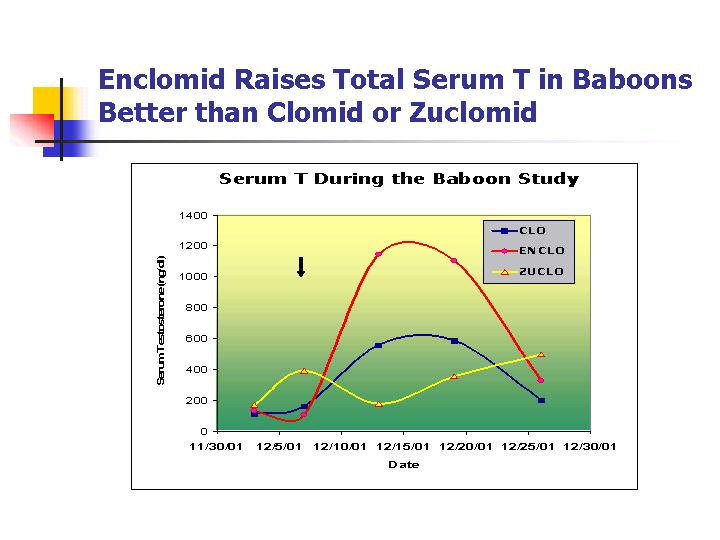
| Enclomid Raises Total Serum T in Baboons Better than Clomid or Zuclomid |

| Methods Part C. Species: Humans Method: a randomized, double-blind, placebo-and active-controlled study in hypogonadal men Subjects at screening were low-to- borderline (99 to 334 ng/dL) in total testosterone with normal LH and FSH. |
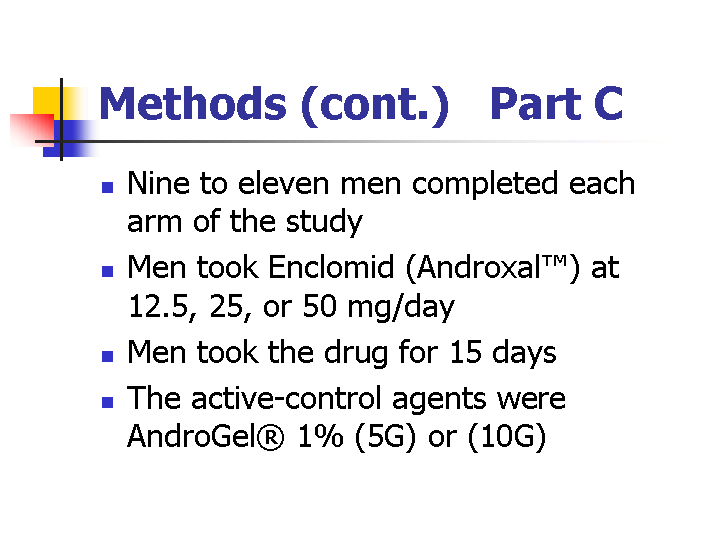
| Methods (cont.) Part C Nine to eleven men completed each arm of the study Men took Enclomid (Androxal(tm)) at 12.5, 25, or 50 mg/day Men took the drug for 15 days The active-control agents were AndroGel(r) 1% (5G) or (10G) |
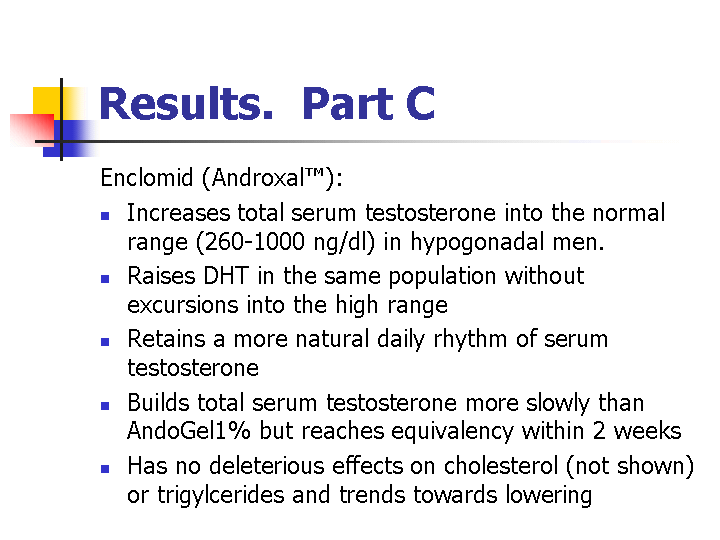
| Results. Part C Enclomid (Androxal(tm)): Increases total serum testosterone into the normal range (260-1000 ng/dl) in hypogonadal men. Raises DHT in the same population without excursions into the high range Retains a more natural daily rhythm of serum testosterone Builds total serum testosterone more slowly than AndoGel1% but reaches equivalency within 2 weeks Has no deleterious effects on cholesterol (not shown) or trigylcerides and trends towards lowering |
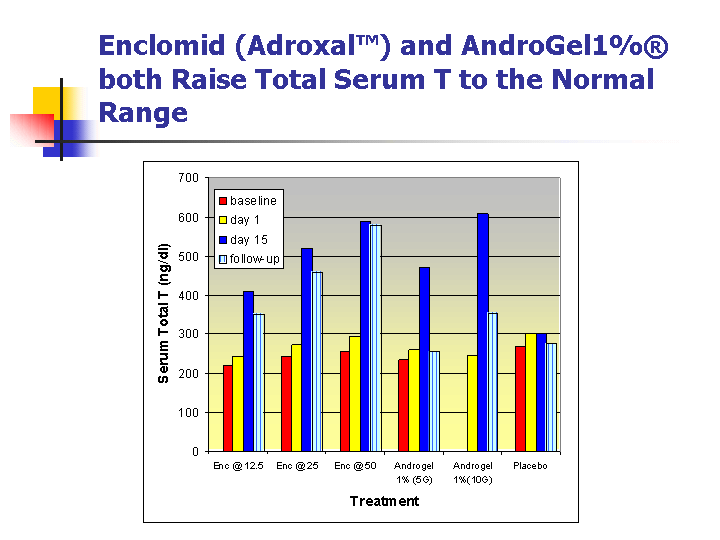
| Enclomid (Adroxal(tm)) and AndroGel1%(r) both Raise Total Serum T to the Normal Range |

| Androxal(tm) Raises DHT into the Normal Range (25-75ng/dL) but not Beyond |
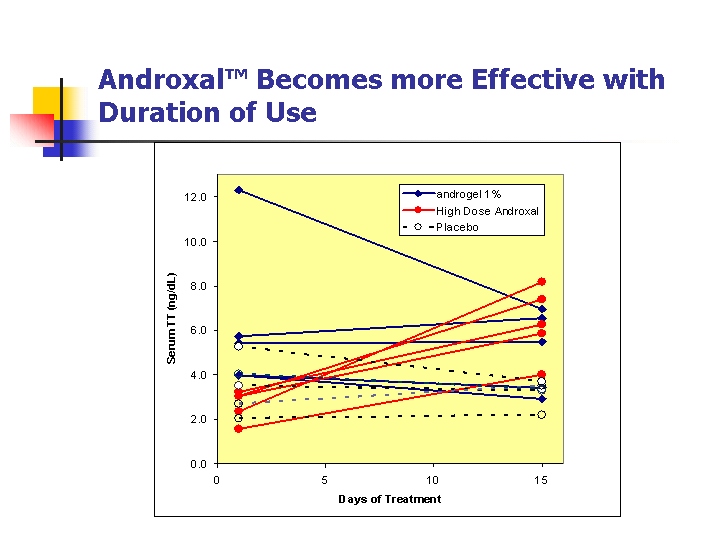
| Androxal(tm) Becomes more Effective with Duration of Use |
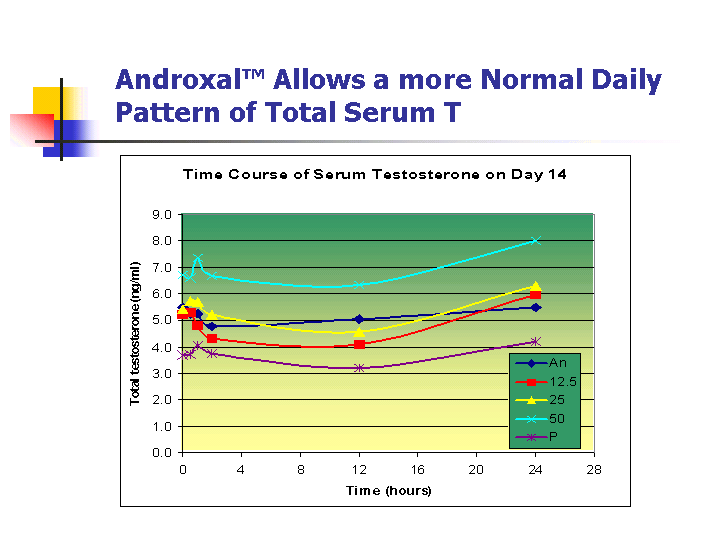
| Androxal(tm) Allows a more Normal Daily Pattern of Total Serum T |
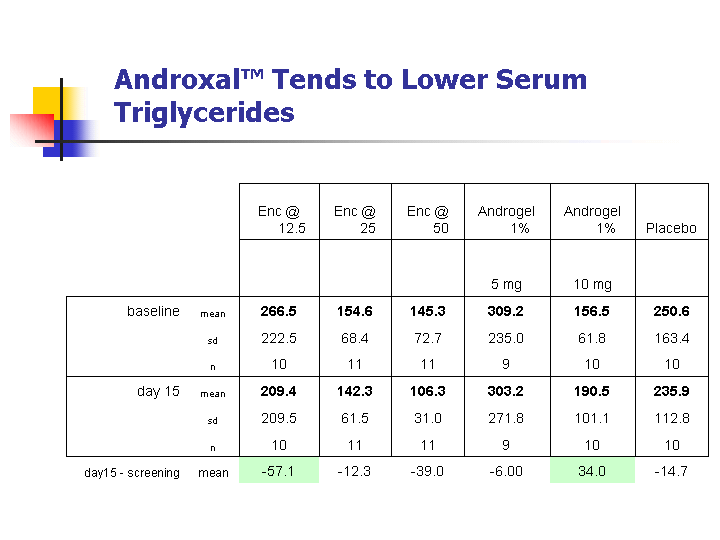
| Androxal(tm) Tends to Lower Serum Triglycerides Enc @ 12.5 Enc @ 25 Enc @ 50 Androgel 1% Androgel 1% Placebo 5 mg 10 mg baseline mean 266.5 154.6 145.3 309.2 156.5 250.6 sd 222.5 68.4 72.7 235.0 61.8 163.4 n 10 11 11 9 10 10 day 15 mean 209.4 142.3 106.3 303.2 190.5 235.9 sd 209.5 61.5 31.0 271.8 101.1 112.8 n 10 11 11 9 10 10 day15 - screening mean -57.1 -12.3 -39.0 -6.00 34.0 -14.7 |
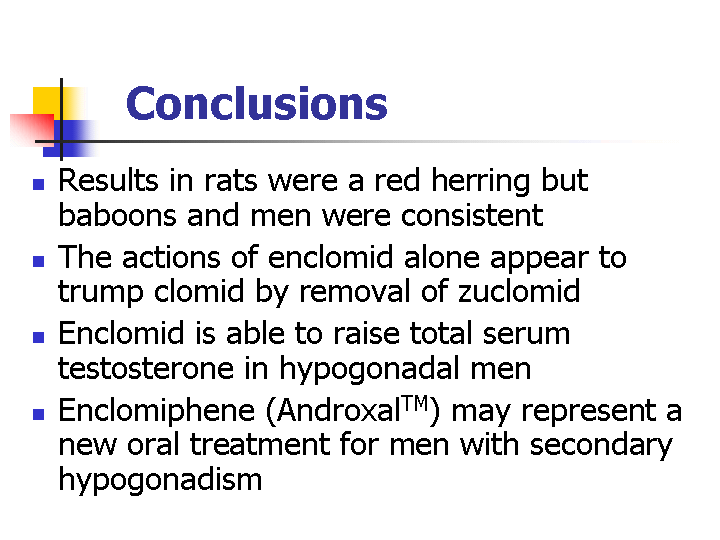
| Conclusions Results in rats were a red herring but baboons and men were consistent The actions of enclomid alone appear to trump clomid by removal of zuclomid Enclomid is able to raise total serum testosterone in hypogonadal men Enclomiphene (AndroxalTM) may represent a new oral treatment for men with secondary hypogonadism |
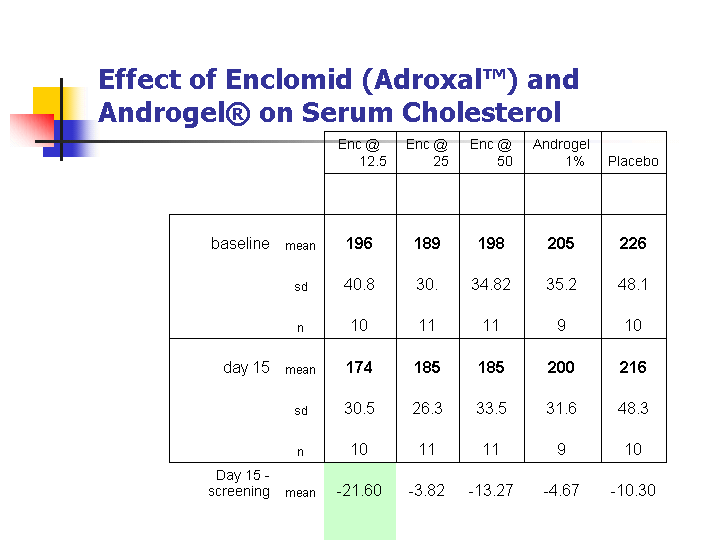
| Effect of Enclomid (Adroxal(tm)) and Androgel(r) on Serum Cholesterol Enc @ 12.5 Enc @ 25 Enc @ 50 Androgel 1% Placebo baseline mean 196 189 198 205 226 sd 40.8 30. 34.82 35.2 48.1 n 10 11 11 9 10 day 15 mean 174 185 185 200 216 sd 30.5 26.3 33.5 31.6 48.3 n 10 11 11 9 10 Day 15 - screening mean -21.60 -3.82 -13.27 -4.67 -10.30 |